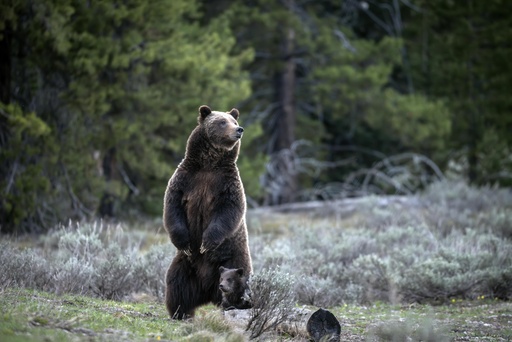
CHEYENNE, Wyo. — The recent death of a renowned grizzly bear, known as No. 399, on a highway in western Wyoming has left her cub orphaned, but experts believe that the young bear’s chance of survival remains promising, even as winter approaches.
Justin Schwabedissen, a bear biologist at Grand Teton National Park, expressed optimism regarding the yearling’s potential to thrive on its own, stating that it possesses “high chances of survival going forward for the year.” This news has provided some comfort to those concerned about the well-being of the cub, which has not been sighted since the fatal incident on Tuesday.
On social media platforms, particularly a popular Facebook group dedicated to tracking the bear and its offspring, many users have voiced their concerns for the cub, affectionately dubbed “Rowdy” or “Spirit.” Some commenters advocate for an intervention to locate and rescue the cub, while others support the standard wildlife management practice of allowing nature to take its course. To date, there has been no official announcement regarding a search for the cub.
Had the cub been born last winter, the outlook for its survival would have been significantly bleaker. However, being nearly two years old and in good health, combined with the upcoming winter season when it can safely den, contributes to the cub’s favorable situation, according to biologists.
In addition to road accidents, grizzly bears in the region face threats from hunting activities, as their curiosity can lead them into dangerous encounters with elk hunters drawn in by the scent of carcasses. Moreover, bears that develop a taste for human food sources, such as garbage or pet food, pose risks to themselves and nearby residents.
Grizzly No. 399 was not only a beloved figure but also the oldest known reproducing female grizzly in the Yellowstone ecosystem. Over her 28 years, she birthed 18 cubs across eight litters, often seen socializing with them near roadways in Grand Teton, which endeared her to tourists and wildlife enthusiasts alike. Her popularity sometimes led to significant traffic congestion as crowds gathered to observe her.
This area is also home to other notable wildlife. Last summer, a rare white buffalo calf in Yellowstone captured the public’s imagination. With few sightings after its birth, the calf became the subject of local Native American lore, believed to herald a positive change.
In 2009, another well-known animal, a 725-pound bull elk known by an ear tag, gained notoriety until he met an untimely end at the age of 15 due to an unfortunate accident involving a fence. While some wild animals have gained fame only through their demise, Grizzly No. 399’s legacy is one of inspiration and appreciation for her species as grizzly populations in Yellowstone have rebounded significantly from around 100 individuals in the 1970s to about 1,000 today.
Remarkably, some of Grizzly 399’s older offspring have also produced cubs, ensuring her genetic line continues in the wild. “She truly was an icon and ambassador for not only her species but also the wildness of the Greater Yellowstone Ecosystem,” noted Chip Jenkins, the Grand Teton Superintendent.
